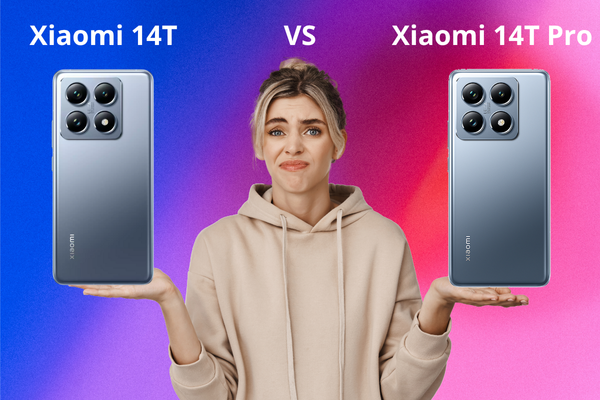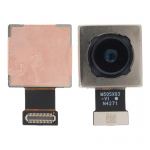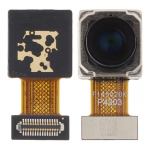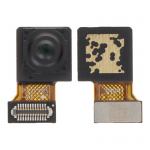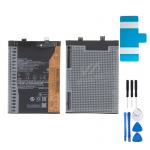Difference between Xiaomi 14T and Xiaomi 14T Pro
Publicado por MariaDifference Between Xiaomi 14T and Xiaomi 14T Pro ?
Hello, tech-lovers and loyal followers of iLevante.com! ? Today we dive into the Xiaomi universe to dissect two of its latest beasts: the Xiaomi 14T and its bigger brother, the Xiaomi 14T Pro. If you're thinking about upgrading your phone, or you're simply a tech enthusiast, this is your spot. Let's see what sets them apart, which could be your technological soulmate, and very importantly, how to keep them in top shape if any issues arise (wink, wink, spare parts!). Because at iLevante.com, we not only inform you but also accompany you throughout your device's lifespan, offering the best Xiaomi parts to ensure your phone is always at 100%.
Design and Display: Love at First Sight (and Touch) ?
The first contact with a smartphone is crucial, and both the Xiaomi 14T and the 14T Pro aim to impress right from the start. It's not just about aesthetics but also the sturdiness and quality of the screen, that component we look at so often and that sometimes needs a Xiaomi screen replacement.
Build and Durability: Will They Keep Up With Your Pace?
When discussing the structure of these devices, we find subtle but significant differences that can influence the purchase decision and long-term durability.
The Xiaomi 14T features dimensions of 160.5 x 75.1 x 7.8 mm (or 8.0 mm in some variants) and a weight of about 193 g or 195 g. Its materials include a glass front protected by Corning Gorilla Glass 5, a plastic frame, and a glass back (Panda X). This combination seeks a balance between aesthetics and lightness.
Meanwhile, the Xiaomi 14T Pro is slightly thicker and heavier, with 160.4 x 75.1 x 8.4 mm and 209 g. The main difference lies in its frame, which is made of aluminum (6M13 aluminum alloy), giving it a more premium feel and greater structural rigidity. The front also features Gorilla Glass 5, and the back is Panda X glass. This aluminum frame not only enhances the perception of quality but could also offer better resistance to twists or small bumps, a factor to consider if you ever need to look for Xiaomi casing replacements.
Both models come with IP68 certification, meaning they are dust and water-resistant, capable of being submerged up to 2 meters for 30 minutes according to specifications. This is excellent news for overall durability and helps prevent the need to repair Xiaomi for water damage, although always with due caution.
Captivating Displays: An AMOLED Visual Feast
In the screen department, Xiaomi has decided not to skimp, offering a top-notch visual experience on both devices. The specifications are practically identical, which is a big plus for the standard model.
Both the Xiaomi 14T and the 14T Pro feature a 6.67-inch AMOLED panel with a resolution of 1220 x 2712 pixels (~446 ppi) and a spectacular refresh rate of 144Hz. This high refresh rate translates to exquisite fluidity when browsing, gaming, or simply interacting with the device. They support 68 billion colors, Dolby Vision, and HDR10+. Brightness is also a strong point, reaching 1600 nits (HBM) and a peak of 4000 nits, ensuring good visibility even under direct sunlight. Protection is provided by Corning Gorilla Glass 5, a robust standard that helps prevent scratches and cracks, although it's not infallible, and an unfortunate drop could lead to needing to buy Xiaomi 14T Pro screen or for its smaller sibling.
It's worth noting that despite the high peak brightness figures, some tests like DXOMARK for the Xiaomi 14T (screen score of 142) mention a "lack of brightness and detail when viewing HDR10 videos and when used under sunlight." This could indicate that peak brightness is achieved under very specific conditions or in small areas of the screen, and sustained brightness across the entire surface could be lower. Nevertheless, DXOMARK also highlights the good color reproduction and screen fluidity of the 14T. If outdoor visibility is an absolute priority, this nuance is important. If you're looking for a new Xiaomi 14T screen, the base technology is of high quality, but real performance under direct sunlight is an aspect to consider.
Unleashed Power: Processors and Performance Under the Hood ?
The heart of any modern smartphone is its processor, and here is where we find one of the most notable differences between the 14T and the 14T Pro. Both are powerful, but they target slightly different performance segments.
The Beast's Heart: Chipsets Examined
The Xiaomi 14T is powered by the MediaTek Dimensity 8300 Ultra, a highly capable 4 nm chipset. Its octa-core CPU is configured with 1 Cortex-A715 core at 3.35 GHz, 3 Cortex-A715 cores at 3.20 GHz, and 4 Cortex-A510 cores at 2.20 GHz, accompanied by a Mali G615-MC6 GPU. In performance tests, this chip delivers respectable numbers, such as an AnTuTu (v10) score of 1,253,994. This is considered a "high-mid-range SoC," more than sufficient for the vast majority of users.
The Xiaomi 14T Pro raises the stakes with the formidable MediaTek Dimensity 9300+, also a 4 nm SoC. This is a "flagship SoC" with an octa-core CPU that includes 1 Cortex-X4 core at 3.4 GHz, 3 Cortex-X4 cores at 2.85 GHz, and 4 Cortex-A720 cores at 2.0 GHz, along with the powerful Immortalis-G720 MC12 GPU. The differences in performance tests are evident: AnTuTu (v10) reaches 2,015,655 points. This leap in power translates to superior handling of games with maximum graphics, intensive multitasking, and faster image and video processing, including the ability to record in 8K. If the Xiaomi 14T Pro motherboard ever needs replacement, its cost is likely to be higher due to this more advanced chip.
RAM and Storage: Speed and Space
Both devices are well-equipped in terms of memory. The Xiaomi 14T offers options of 256GB or 512GB of storage with 12GB of RAM, and even a 512GB variant with 16GB of RAM. Some sources also mention an 8GB RAM version, which could be specific to certain regions.
The Xiaomi 14T Pro also starts at 256GB or 512GB with 12GB of RAM and offers variants of 512GB or up to 1TB of storage with 16GB of RAM. This 1TB option is ideal for those who record a lot of high-resolution video or store a large number of games and heavy files.
A great feature in both models is the inclusion of UFS 4.0 internal storage. This technology ensures ultra-fast read and write speeds, resulting in faster app installations, reduced load times in games, and an overall sense of greater system agility. However, it's important to note that neither model has an SD card slot. This makes choosing the initial storage capacity crucial, as there will be no way to physically expand it later. If the internal storage fails, repair would involve direct intervention on the Xiaomi motherboard, where this component resides.
Photography Duel: How Are the Leica Cameras in the 14T and 14T Pro? ?
The collaboration with Leica remains a cornerstone of Xiaomi's photography strategy, and both the 14T and 14T Pro aim to deliver a high-quality camera experience. While they share the Leica brand, there are hardware differences that could tip the scales.
Rear Camera System: A Closer Look at the Lenses
The Xiaomi 14T features a triple system:
- Main: 50 MP, f/1.7 aperture, 1/1.56" sensor, 1.0Ám pixels, PDAF, and OIS.
- Telephoto: 50 MP, f/1.9, 1/2.76" sensor, 2x optical zoom, PDAF.
- Ultra-Wide Angle: 12 MP, f/2.2, 15mm.
It allows video recording up to 4K at 60fps. DXOMARK gives it a camera score of 134, highlighting good portraits and landscapes outdoors but with weaknesses in low light. Its zoom score is 140.
If your camera has suffered any defect or stopped working, there are spare parts to replace the original.
The Xiaomi 14T Pro also features a triple setup but with key improvements:
- Main: 50 MP, f/1.6 aperture (brighter), 1/1.31" sensor (larger), 1.2Ám pixels, PDAF, and OIS.
- Telephoto: 50 MP, f/2.0, 1/2.88" sensor, 2.6x optical zoom (greater reach), PDAF.
- Ultra-Wide Angle: 12 MP, f/2.2, 15mm (apparently identical to the 14T's).
The main difference lies in the Pro's main sensor, which, being larger and having a greater aperture (f/1.6 vs. f/1.7), should capture more light. This is theoretically a significant advantage in low-light conditions, resulting in cleaner and more detailed images and better natural bokeh. The Pro's telephoto lens also offers slightly more optical reach (2.6x vs. 2x). Although some users perceive that the differences in the final output can be subtle in good lighting conditions, the Pro would have an advantage in dynamic range and video quality. If you need a replacement Xiaomi camera lens, the Pro's could be more specific or expensive due to these differences. For photography enthusiasts, these technical details in the Pro's sensor and zoom can be decisive.
Front Camera (Selfies)
As for the front camera, it seems Xiaomi has opted for uniformity. Both models, the 14T and the 14T Pro, are equipped with a 32 MP sensor with f/2.0 aperture and a 25mm focal length (wide). Both support HDR and can record video in 4K at 30fps and 1080p up to 60fps, with HDR10+.
Battery Life and Charging: Who Lasts Longer and Gets Back to the Ring Faster? ??
The battery is a critical component, and here both phones start from a solid base, but the Pro stands out significantly in recharge speed. If you need a Xiaomi 14T battery replacement or repair Xiaomi 14T Pro charging connector, the technology involved could be a factor.
Battery Capacity
Both the Xiaomi 14T and the Xiaomi 14T Pro feature a 5000 mAh Li-Po battery. On paper, this should translate to similar battery life. However, the chipset's efficiency can play a role. It is suggested that the Dimensity 9300+ of the 14T Pro could be slightly more energy-efficient, giving it an advantage of between 3-5% in daily battery life or an extra one or two hours of use. DXOMARK, for instance, measured a battery life of 2 days and 3 hours for the Xiaomi 14T.
Charging Speed
Here is where the differences are most striking and where the Xiaomi 14T Pro truly shines.
The Xiaomi 14T supports fast wired charging of 67W with Power Delivery 3.0. Xiaomi claims it can reach 100% charge in 45 minutes. DXOMARK tests indicate it can charge from 0 to 80% in 28 minutes and a full charge in 46 minutes, which is quite fast and very convenient for most users.
The Xiaomi 14T Pro, on the other hand, is a true charging beast. It offers wired charging of 120W (PD3.0, QC4), capable of taking the battery from 0 to 100% in just 19 minutes, according to official figures. This speed is transformative, allowing hours of use with just a few minutes plugged in. But that's not all: the Pro also includes 50W wireless charging, which can charge the phone to 100% in 45 minutes. This is a significant advantage in terms of convenience and can also help reduce wear on the USB-C port over time if used frequently.
The difference in wired charging speed is, therefore, vast. While 45 minutes for a full charge on the 14T is good, the Pro's 19 minutes are simply spectacular and can radically change a user's charging habits.
Comparison Table: Xiaomi 14T vs. Xiaomi 14T Pro in Detail ?
To see the differences clearly and concisely, there's nothing better than a comparison table. Here we summarize the key specifications of both contenders. Remember that if you need any Xiaomi screen replacement or any other part, knowing the specifications well is the first step.
| Feature | Xiaomi 14T | Xiaomi 14T Pro |
|---|---|---|
| Screen (Type) | AMOLED, 68B colors, Dolby Vision, HDR10+ | AMOLED, 68B colors, Dolby Vision, HDR10+ |
| Screen (Size) | 6.67 inches | 6.67 inches |
| Screen (Resolution) | 1220 x 2712 pixels | 1220 x 2712 pixels |
| Screen (Refresh Rate) | 144Hz | 144Hz |
| Screen (Peak Brightness) | 4000 nits | 4000 nits |
| Screen (Protection) | Corning Gorilla Glass 5 | Corning Gorilla Glass 5 |
| Processor (Chipset) | MediaTek Dimensity 8300 Ultra (4 nm) | MediaTek Dimensity 9300+ (4 nm) |
| RAM (Options) | 8GB, 12GB, 16GB | 12GB, 16GB |
| Storage (Options) | 256GB, 512GB | 256GB, 512GB, 1TB |
| Storage (Type) | UFS 4.0 | UFS 4.0 |
| SD Slot | No | No |
| Main Camera (Main Sensor) | 50 MP, f/1.7, 1/1.56", OIS | 50 MP, f/1.6, 1/1.31", OIS |
| Main Camera (Telephoto) | 50 MP, f/1.9, 2x optical zoom | 50 MP, f/2.0, 2.6x optical zoom |
| Main Camera (Ultra-Wide) | 12 MP, f/2.2 | 12 MP, f/2.2 |
| Main Video (Max Resolution) | 4K@60fps | 8K@30fps |
| Front Camera | 32 MP, f/2.0 | 32 MP, f/2.0 |
| Battery (Capacity) | 5000 mAh | 5000 mAh |
| Wired Charging (Power) | 67W | 120W |
| Wired Charging (0-100% Time) | ~45 min (claimed) | ~19 min (claimed) |
| Wireless Charging | No | 50W (100% in 45 min claimed) |
| Build (Frame Materials) | Plastic | Aluminum |
| Weight | 193g / 195g | 209g |
| Dimensions | 160.5 x 75.1 x 7.8/8.0 mm | 160.4 x 75.1 x 8.4 mm |
| Resistance (IP Rating) | IP68 | IP68 |
| Operating System (Launch) | Android 14, HyperOS | Android 14, HyperOS |
| Connectivity (Wi-Fi) | Wi-Fi 6e | Wi-Fi 7 |
| Connectivity (Bluetooth) | 5.4 | 5.4 |
Breaking Down the Table: Key Differences Explained ?
The table gives us an overview, but let's delve into what these differences truly mean for a user looking for a new phone or even parts to repair Xiaomi.
Performance and Power: The leap from the Dimensity 8300 Ultra in the 14T to the Dimensity 9300+ in the 14T Pro is not merely a figure on paper. It translates to a noticeably more agile and powerful user experience on the Pro, especially when running games at maximum graphics, performing intensive multitasking, or editing video. The Pro's ability to record in 8K is a clear example of this additional power. For those seeking maximum performance without compromises, the Pro is the clear winner. This processor difference is fundamental and largely justifies the existence of a "Pro" version.
Professional vs. Advanced Photography: Both devices carry the prestigious Leica badge and 50MP main sensors, but the Pro has some aces up its sleeve. Its main sensor is physically larger and has a wider aperture (f/1.6 vs. f/1.7), allowing it to capture more light. This, along with its telephoto lens with greater optical reach (2.6x vs. 2x), gives it a qualitative edge, especially in low-light scenarios and when zooming. The Xiaomi 14T remains a very strong photography contender, but the Pro is a notch above for the most demanding users. However, it's important to remember that processing software plays a crucial role, and Xiaomi aims for consistent Leica branding. For the average user, the differences in good lighting conditions might be subtle.
Battery and Charging: The Pro Revolution: While both share a generous 5000 mAh battery, the Xiaomi 14T Pro redefines the charging experience. Its 120W wired charging can fully charge the battery in approximately 19 minutes, an astounding figure. Additionally, the inclusion of 50W wireless charging on the Pro adds a highly valued layer of convenience. The Xiaomi 14T, with its 67W, already offers very competitive fast charging (about 45 minutes for 100%), but the Pro simply plays in another league in this aspect. If you hate waiting for your phone to charge, this is one of the most compelling reasons to opt for the Pro.
Build and Subtle Nuances: The aluminum frame of the Xiaomi 14T Pro not only gives it a more premium feel compared to the plastic frame of the 14T but also provides extra structural robustness. In other design aspects, such as IP68 protection and the use of Gorilla Glass 5, both devices are on par, offering good overall durability.
Strengths: The Best of the Xiaomi 14T and Xiaomi 14T Pro ?
Each model has its aces up its sleeve, designed to attract different types of users. Here we highlight the best of each to help you decide, and remember that for any Xiaomi mobile spare part, iLevante.com is your ally.
Xiaomi 14T: The Perfect Balance ??
- Outstanding Performance for Most: Its MediaTek Dimensity 8300 Ultra chip is a powerful engine that smoothly handles all current apps and games, offering a fluid experience without the added cost of the Pro's processor. It's more than enough for 95% of users.
- First-Class Display: Enjoy the same quality AMOLED panel at 144Hz as its bigger brother, ensuring a vibrant and fluid visual experience for consuming multimedia content, browsing social media, or gaming.
- Efficient Fast Charging: Its 67W power fills the 5000 mAh battery in about 45 minutes. While not the Pro's 120W, it remains a very competitive and extremely convenient speed for everyday use.
- Versatile Photography with Leica Branding: Although it doesn't have the largest main sensor or the most powerful zoom of the Pro, its camera system offers great quality and versatility, allowing you to capture excellent photos with the prestigious Leica branding at a more affordable price. Its DXOMARK score of 134 supports it as a great photographic contender.
Xiaomi 14T Pro: The Unleashed Beast ?
- Extreme Power: The MediaTek Dimensity 9300+ places it at the pinnacle of Android performance. It's the ideal phone for hardcore gamers, users who perform intensive multitasking, or those who simply want the maximum possible fluidity and speed.
- HyperSpeed Charging and Wireless Convenience: The 120W wired charging that fills the battery in about 19 minutes is revolutionary. Additionally, the 50W wireless charging adds a layer of comfort and sophistication that many will appreciate.
- Superior Main Camera and Improved Zoom: The larger main sensor (1/1.31") with greater aperture (f/1.6), along with the 2.6x optical zoom, makes a tangible difference for photography enthusiasts, especially in low-light conditions and when seeking maximum detail in distant shots.
- 8K Video: For content creators or those who want the highest video resolution available for future editing or to enjoy on ultra-high-definition screens, the ability to record in 8K is an important plus.
- Premium Build and Advanced Connectivity: The aluminum frame gives it a more robust and elegant finish. Additionally, it features Wi-Fi 7, the latest in wireless connectivity technology, offering potentially higher speeds and lower latency.
Heads Up! Common Issues and Frequent Problems in Xiaomi 14T and 14T Pro ??
Although the Xiaomi 14T and 14T Pro are impressive machines, like any technological device, they are not exempt from potential issues over time or due to accidents. Based on experience with previous models like the Xiaomi 13T/Pro and general smartphone problems, here are some of the most common faults that might require repair or a Xiaomi spare part. Prevention is better than cure, and at iLevante.com, we are ready to help you with the replacement parts for your Xiaomi!
Screen Problems: The Achilles' Heel of Many Phones
The screen is one of the most exposed components and, therefore, one of the most likely to suffer. Here are the most common issues:
- Cracks and Breaks: It's a classic. Despite Gorilla Glass 5 protection, an unfortunate drop can result in a broken or cracked screen, necessitating a Xiaomi 14T screen replacement or 14T Pro. At iLevante.com, you can find complete screens for Xiaomi that include the LCD and digitizer.
- Touch Failures: The screen may stop responding to touch, respond erratically, or exhibit "ghost touches." This can be due to software issues, accumulated dirt, or damage from an internal impact. Sometimes, superficial cleaning isn't enough, and a Xiaomi screen replacement is required.
- Spots or Dead Pixels: Appearance of unusual color spots, light leaks at the edges, or pixels that get "stuck" on a color or are completely off. These problems usually require replacing the AMOLED panel.
- Moisture Damage: While they are IP68 certified, this protection isn't foolproof. If the seals are damaged (e.g., after a drop) or if liquid exposure exceeds the certification limits, moisture can enter and wreak havoc: screen spots, internal corrosion, or widespread failures. If this happens, it's crucial to act quickly and seek a qualified repair service.
iLevante to the Rescue: At iLevante.com, we understand how frustrating it is to have a damaged screen. That's why we offer replacement screens for Xiaomi 14T and 14T Pro, with all necessary components (LCD, touch, flex cable) and even, in many cases, we gift you a tool kit to facilitate installation, similar to what we do for other models.
Battery and Charging: When Energy Fails
Battery life is vital, and issues related to the battery or charging can leave you disconnected at the worst moment.
- Battery Degradation: With use and charging cycles, all lithium-ion batteries lose capacity over time. If you notice that the battery of your Xiaomi 14T or 14T Pro lasts significantly less than it used to, it is likely degraded and needs replacement.
- Charging Issues: The phone doesn't charge, charges intermittently, or extremely slowly. Causes can vary: a defective Xiaomi charger, a damaged cable, dirt or lint accumulated in the Xiaomi 14T Pro USB-C charging port, or a fault in the phone's charging connector itself. Cleaning the port carefully is usually the first step.If the problem persists, it might be necessary to repair the Xiaomi charging connector.
- Overheating While Charging: Although modern fast charging systems (like 67W and 120W) incorporate multiple protections, excessive overheating during charging could be a symptom of a problem with the battery, the charger, or the charging circuit itself.
- Phone Not Turning On: In some cases, a phone that won't turn on may be due to a completely drained, defective, or end-of-life battery. Before considering more serious problems, checking the battery status is essential.
iLevante Solutions: We offer high-quality replacement batteries for Xiaomi so you can restore your device's original autonomy. We can also advise you on charging-related issues. It's important to remember that replacing a Xiaomi battery is a delicate process that, if not done carefully, can damage other components.
Other Potential Hardware Issues
Beyond the screen and battery, other components may fail:
- Device Overheating: Although the Dimensity 8300 Ultra and 9300+ chipsets have good thermal management, very intensive use (demanding games for hours), running heavy applications, or direct exposure to sunlight can cause overheating. If persistent, it could indicate an underlying issue.
- Connectivity Failures (Wi-Fi, Bluetooth): Issues connecting to Wi-Fi networks, frequent disconnections, or inability to pair Bluetooth devices. Sometimes these are software issues, but they can also be due to failures in the internal antennas or connectivity module.
- Software Problems (Freezing, Restarts): Although not strictly a hardware failure, unstable software, frequent freezing, or unexpected restarts can sometimes be symptoms of a failing hardware component (like RAM or storage) or indicate the need for a deeper review.
- Stuck or Faulty Physical Buttons: Volume buttons or the power button can get stuck or stop working correctly due to wear or dirt ingress. At iLevante.com, you can find button flex cables for Xiaomi.
- Speakers with Distorted or No Sound: If the speaker sound quality is poor, very low, or nonexistent, it might be due to obstruction of the grills or a failure of the Xiaomi speaker itself.
- Cameras That Don't Focus or Show Artifacts: If the main or front camera doesn't focus properly, shows spots, or strange artifacts in the images, and external lens cleaning doesn't solve the issue, it might be a case of a defective Xiaomi camera module that needs replacement.
For many of these hardware issues, the solution involves replacing the damaged component. At iLevante.com, we strive to have a comprehensive catalog of replacement parts for Xiaomi phones, including the most common ones like screens and batteries, as well as more specific components like charging connectors, flex cables, speakers, and cameras.

